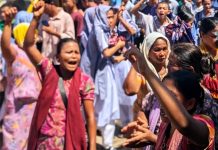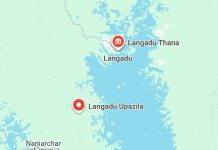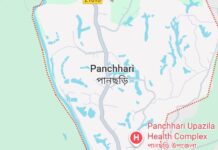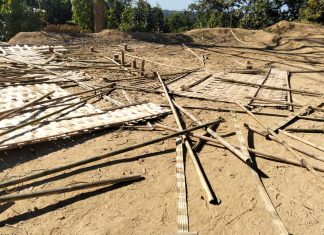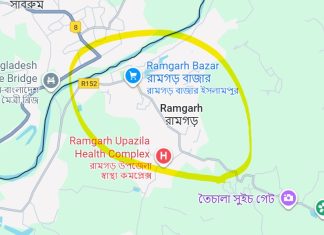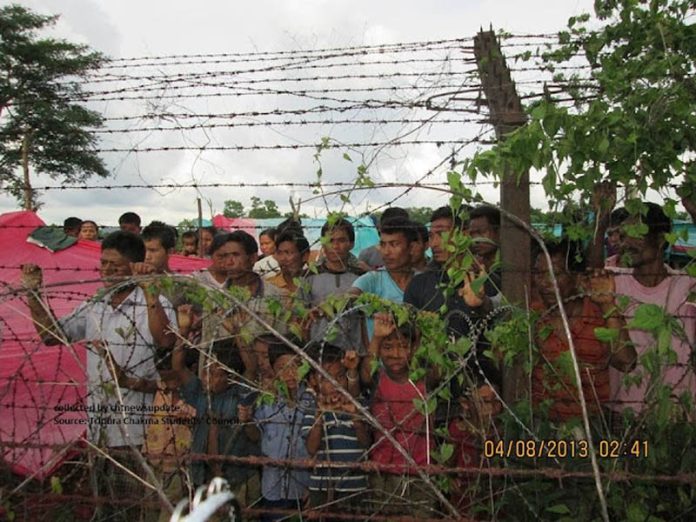
One striking difference between the Palestinians and the Jummas is that while the former have the eyes of the whole world on them, the latter fails to even draw national media attention. That is one of the reasons why Palestine, with a land area smaller than that of the CHT, enjoys a groundswell of support worldwide for its just cause, writes Samari Chakma
Hundreds of villagers were forced to take refuge on ‘no-man’s land’ on the India-Bangladesh border following the August 3, 2013 attack at Taindong. — CHTnewsupdate
THE print and electronic media in Bangladesh are giving wide coverage, quite expectedly and understandably, to the ongoing Israeli attacks on Gaza. Even when no major conflicts are there, the media covers the Palestinian issue, almost daily. Courtesy of the media, we know the gory details of the conflict: the casualties, the destruction of Palestinian houses, Israeli shelling on schools, hospitals, UN buildings and other infrastructures, the worldwide protests against this savage attack, efforts of the world leaders, including United Nations secretary general Ban Ki-moon, to mediate a ceasefire between Israel and the Palestinian resistance movement Hamas and so on.
However, the media in Bangladesh generally appears somewhat reluctant about regular updates on what is happening in our own Palestine — the Chittagong Hill Tracts. How many people in Bangladesh know about the forcible acquisition of land for the Border Guard Bangladesh that has resulted in the displacement of 21 Jumma families at Babuchara in Khagrachari? The intensity of the conflict and the global attention aside, there are many similarities between Palestine and the Chittagong Hill Tracts. Both the Palestinians and the Jummas are persecuted peoples. The only difference, perhaps, is that the Palestinians are victims of a foreign state called Israel while the Jummas are persecuted by the authorities of their own country, Bangladesh.
The creation of the state of Israel in 1948 on Arab land turned about three quarters of a million of Palestinians into refugees. Similarly, albeit on a lesser degree, the construction of a dam on the river Karnaphuli or Borgang, as the Chakmas call it, in the hill tracts in the 1960s submerged 54,000 acres of arable land and displaced some 100,000 people, mostly Chakmas, 60 per cent of whom subsequently migrated to India. The migrant Chakmas continue to lead the life of stateless persons or refugees in the Indian state of Arunachal, just as Palestinian refugees are denied their right of return, in line with the UN Resolution 194, by Israel. While Israel has built (and continues to build) illegal Jewish settlements on Palestinian lands, the government of Bangladesh has sponsored transmigration of 400,000 landless Bengalis to the CHT.
Under Israeli occupation, Palestinians watch helplessly as Israelis take over their lands. Similarly, land grabbing by Bengali settlers and our governments is commonplace in the CHT. The Israelis carry out military offensives against Palestinians on slightest pretexts; the Bengali settlers, with backing from the security forces, perpetrate attacks on Jummas — with or without any pretexts. The Palestinians and especially the Gazans live in virtually an open prison, with Israel controlling its borders, sea and air space. In much the same way, the Jummas live in a heavily militarised zone with restricted rights.
The Palestinians have a peace treaty — the Oslo Accord of 1993 — signed by the late chairman of the Palestine Liberation Organisation, Yasser Arafat, and the then Israeli prime minister, Yitzhak Rabin, under US mediation. For the Jumma people, there is the CHT accord of 1997 signed without any third-party mediation. However, it must be noted that both these treaties have failed to bring peace in their respective territories. Again, the Palestinians have their self-government institution, the Palestinian Authority, which is known to be tainted by corruption, while the less said about the rampant corruption of the CHT Regional Council headed by Santu Larma, the better.
One can go on pointing out such similarities between the two unfortunate peoples, but one striking difference between the Palestinians and the Jummas is that while the former have the eyes of the whole world on them, the latter fails to even draw national media attention. That is one of the reasons why Palestine, with a land area smaller than that of the CHT, enjoys a groundswell of support worldwide for its just cause.
On the other hand, one of the main reasons why the just cause of the Jumma people fails to draw national media attention is that there is little media freedom in the CHT. Despite the fact that the army’s grip on the media has been loosened somewhat over the years, the media people in the CHT are still fettered by restrictions — self-imposed or otherwise. The Taindong attack on August 3, 2013 best illustrates such assertion. The attack, which left 36 houses including a Buddhist temple burnt to ashes and forced hundreds of Jumma villagers to take shelter in ‘no-man’s land’ on the India-Bangladesh border, could have been averted if the media had played its expected role.
A Hill Watch Human Rights Forum report, entitled ‘Fire of Hatred in Taindong’, noted: ‘After the frenzied demonstration on the night of July 31 shouting anti-Jumma slogans, the United People’s Democratic Front had issued a statement next day demanding actions against those responsible for fanning communal tensions in Taindong. Yet, the local administration — both civil and military — paid no heed to the matter. Even the media ignored the UPDF statement; no newspaper or other media outlets published the news of the Jumma villagers in Taindong taking refuge near Indian border following the midnight demonstration on July 31. All this gave encouragement to the settlers to launch attacks on the Jumma people.’
The media also missed two other recent developments in the CHT. One is a renewed attempt to evict Jumma villagers from their land in Sajek to make way for the construction of a BGB battalion headquarters. The other is a decision to rehabilitate 30,000 Bengali settler families reportedly in Babuchara of Khagrachari and in Sajek of Rangamati. According to a report posted on the chtnews.com website, a list of those willing to be rehabilitated is now being prepared. Whatever the motivation for such a decision, any attempt to rehabilitate Bengali settlers on Jumma people’s land is bound to aggravate further the already worsened situation in the region.
Over the decades much blood has been shed in the hills. Even the CHT accord has failed to put an end to it. The people of the CHT deserve to live in peace. While we show solidarity with the suffering Palestinians, let us not forget the people of the CHT. We all have a responsibility to ensure that the CHT does not become even more akin to Palestine — in terms of violence. As Shambhu Rahmat said, ‘Our hearts bleed for Palestine, but when will they bleed for our own people? This is an elegy for the Chittagong Hill Tracts’ (‘My own little Palestine’, The Daily Star, July 10, 2007).
Samari Chakma is a practising lawyer in Khagrachari and former president of Hill Women’s Federation.
Courtesy: Newage
link: http://newagebd.net/36799/our-own-palestine/#sthash.G1955Jyr.epaVlApS.dpbs

